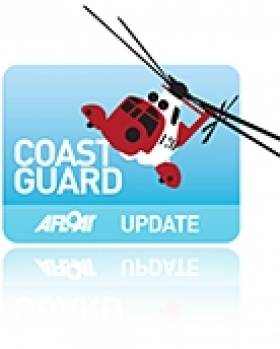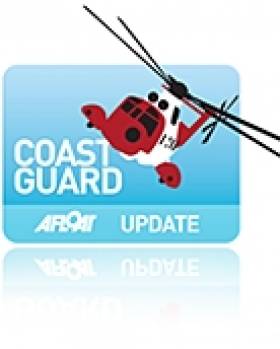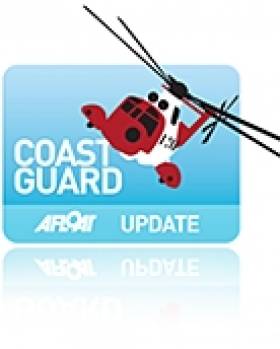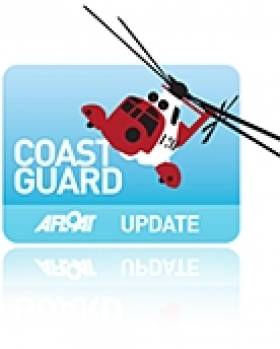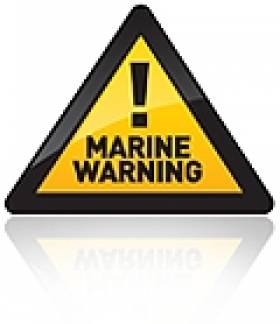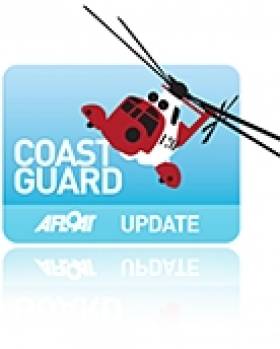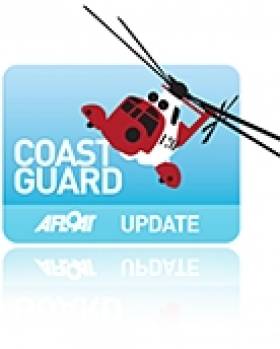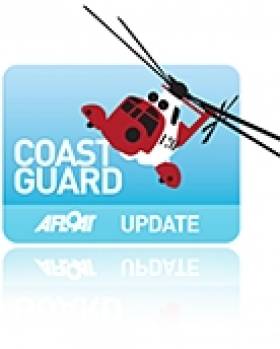Displaying items by tag: Coastguard
Coastguard Pilot Flies 500th Mission
Minister for Transport Noel Dempsey yesterday congratulated an Irish Coast Guard pilot who has just completed his 500th rescue mission, becoming one of a handful of helicopter pilots in western Europe to have done so.
On July 11, operating from the Irish Coast Guard base at Waterford, Capt Rayner and his crew attended an incident 10 nautical miles east of Waterford Airport, where multiple casualties were in difficulty in the water.
On rescuing the party, one injured male was transferred to Waterford Regional Hospital for treatment. With that operation, Capt Rayner joined an elite group of SAR crewmembers who have achieved an impressive 500 rescue missions during their careers.
Ireland’s Minister for Transport, Noel Dempsey, said: "Martyn epitomises the dedication, experience and expertise that makes the Irish Coast Guard one of the best in the world. I congratulate him on his achievement of 500 rescue missions and wish to publicly commend the valuable contribution he has made, and continues to make to SAR in Ireland."
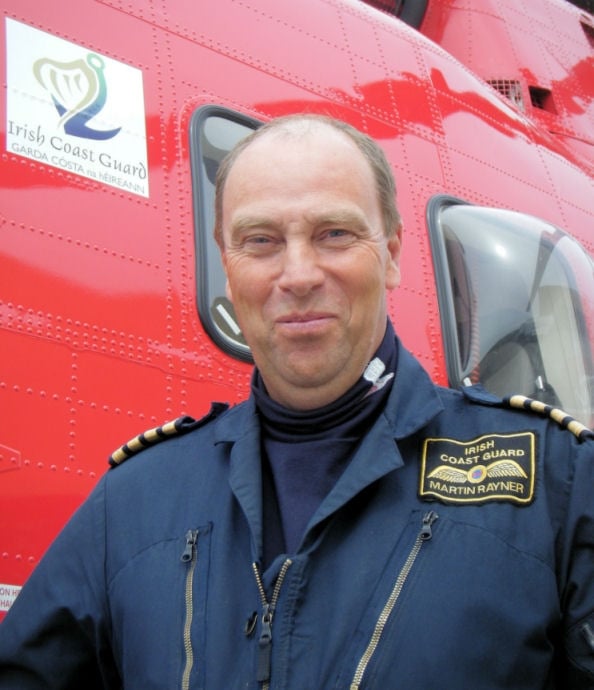
He commenced flying on the Irish Coast Guard contract in 1991 to set up the first Irish Coast Guard SAR base in Shannon Airport. Over the following 10 years Capt Rayner guided the Shannon base as chief pilot, line trainer and SAR Captain. He spent many years flying West of Shannon in all weather conditions, commanding the R115 Shannon base on missions far into the Atlantic Ocean.
“We are delighted for Martyn. This level of experience is rarely seen amongst SAR crew worldwide. We are very pleased to have the benefit of Martyn’s calibre of experience flying SAR missions around our coast,“ said Mark Kelly, managing director of CHC Ireland.
“Most SAR pilots fly an average of 20 missions per year. Martyn has been accident free for his entire career with CHC and is a shining example of our commitment to safety.”
In 2002 Capt Rayner, along with his wife Maureen, temporarily left Irish SAR for the Far East to fly offshore of Brunei. He returned to Ireland in 2005 and was welcomed with open arms to the newly established Waterford Base.
“Everyone at CHC is immensely proud of Capt Rayner’s unique achievement in reaching 500 missions. His vast experience, patience, sense of humour and knowledge of SAR is the backbone of our operation today,“ said Capt Dara Fitzpatrick, chief pilot, CHC Waterford Base.
CHC Ireland is an affiliate of CHC Helicopter through its ownership interest in EEA Helicopter Operations B.V. CHC Helicopter is the world’s largest offshore helicopter operator and provides civilian search and rescue services in Ireland, the UK, Denmark and Australia. Earlier this month another CHC SAR crew was recognized with a “Best of Irish” award for their role in successfully recovering the pilot of a light aircraft that crashed in the Irish Sea.
Warning Issued Over Inflatable Toys Being Swept Out to Sea
Coastguard Sector Manager George Crumpler says,
"Inflatable boats and toys can be great fun, but we'd rather that you used them in swimming pools than at the beach. If you do use one at the beach, tether it to an adult and never use it in an offshore wind. Inflatables can easily be blown out to sea and, overturn.
Make sure that children are properly supervised. We deal with lost children every year and it can be distressing for children and adults alike. Try to go to a lifeguarded beach if you can and stay within the flagged area.
"Remember to check the weather and the tide times (these can often be found at the entrance to the beach) so that the tide doesn't take you by surprise or cut you off.
"If you see anyone in difficulty, tell the lifeguard if one is available or call the Coastguard on 999.
Remember to have a great time and return home safely."
If you want to prepare for your day out on the coast, you might like to visit Directgov for Kids where there are games and activities for children. Visit http://kids.direct.gov.uk/ and click on the world, then go to the 'watch station' in the 'places' icon.
Robot Submarine to be Used in Joint Exercise off Cork Coast
A major marine search and recovery exercise co-ordinated by the Irish Coast Guard will to take place off the Cork coastline this week from 12-15 July 2010 it was announced today.
The exercise, in conjunction with the Marine Institute, the Commissioner for Irish Lights and the Navy, will simulate some major emergency situations including an aircraft crash, recovery of the 'Black Box'. The simulation exercise will also involve deep diving operations and the seeking and survey of a wrecked vessel. It will also incorporate the recovery of items such as ditched contraband and the rendering safe of underwater explosives.
A Service Level Agreement between the Irish Aviation Authority and the Irish Coast Guard was agreed in February of this year. It was agreed that should an aircraft force land in a maritime area, the IAA's Air Rescue Coordination Centre (ARCC) would be responsible for determining the initial search area, but co-ordination shall then transfer to the Coast Guard with continued close co-operation and back-up services from ARCC. As a result of this it was seen that there would need to be close cooperation between all the different agencies and authorities in responding to such a scenario. One of the most important aspects of an aircraft incident investigation is the location and recovery of the aircraft's 'black box'. The Coast Guard, as part of an Agreement with Commissioner of Irish Lights, has chartered their vessel ILV Granuaile, to act as a marine platform for Naval Divers and Holland 1, the Marine Institute's robot submarine a Remotely Operated vehicl e (ROV).
Holland 1 and the Navy Dive Team will be deployed from ILV Granuaile. Primarily used in maintenance of Aids to Navigation the ILV Granuaile is a sophisticated multi functional vessel whose 80-metre length, 16 metre and Dynamic Positioning capability make her an ideal platform for this task. The naval vessel L.E. Eithne will be on site for the duration of the exercise with its Commanding Officer acting as on-scene co-ordinator. The L.E. Eithne will act as the under water crisis management centre for all the personnel involved in the exercise, including the eighteen person naval diving team and the ROV operators and Coast Guard personnel.
Speaking today, Minister Noel Dempsey TD said: "The purpose of this joint exercise is to ensure and examine the level and quality of preparedness in the Irish Coast Guard response and that of our intra-agency partners. Simulations such as are a valuable way to test our co-ordinated emergency response to ensure that in the event of a major emergency, that the appropriate and necessary measures are in place in search, rescue and recovery."
Minister of Defence Mr. Tony Killeen T.D., said that "through Inter Agency co-operation and establishing appropriate protocols for joint exercises we can ensure our ships and our divers are ready to respond in an appropriate and timely manner for given situations."
"While the ROV Holland was acquired primarily as a research vessel, another key function is to provide the capability to assist underwater search and recovery operations," said Mr. Sean Connick, T.D., Minister of State at the Department of Agriculture, Fisheries and Food. "We are therefore delighted to take part in this important exercise, which will involve a combined national ROV team piloting the Holland 1 operated by Naval and Marine Institute pilots."
Holland 1 and Granuaile are available for inter agency work as part of Service Level Agreements between the various parties which promote inter-agency cooperation and the up-skilling of personnel in each organisations for collaborative operations.
Overdue Divers Rescued by Coastguard Helicopter
Liverpool Coastguard received a '999' call at 12:30 pm from the dive boat informing them of the situation and requesting assistance after two divers had not resurfaced and were last seen at 12 noon.
Drumore Coastguard Rescue team was tasked and the Portpatrick and Stranraer, RNLI lifeboats were requested to launch as well as the independent Port William inshore rescue boat. A Rescue helicopter from Prestwick was scrambled to the scene. The vessel 'Go West' assisted in the search.
Paul Campbell, Watch Officer, Liverpool Maritime and Rescue Coordination Centre, said:
"Once the casualty vessel was located the search and rescue units on scene carried out a search around the Mull of Galloway Lighthouse with the Rescue helicopter locating the two casualties and winching them to safety."
The Coastguard always advises divers to let the Coastguard know where and when you will be diving. Always keep a close eye on the weather and sea conditions and make personal fitness a top priority for safe diving. Familiarise yourself with new or different gear before diving and ensure that you dive within your limits.
Lost Vessel Saved From Lough Erne Rocks
A 999 call from the Motor Cruiser ‘Wee Rascal’ on Lough Erne in the early hours of this morning called on all the investigative powers of Belfast Coastguard as the vessel wasn’t even close to its reported position.
The vessel was on passage from Kesh to Enniskillen in windy, wet conditions when it called 999 to ask for assistance. Despite an extensive search of the area around its reported position neither the Enniskillen RNLI Inshore Lifeboat nor Erne Coastguard Rescue Teams could find the vessel.
Because the vessel had no flares, flash lights or VHF Radio on board to show rescuers where it was, Belfast Coastguard resorted to mobile phone technology. A locator i-phone application finally gave rescuers the vital latitude and longitude they needed.
The vessel was finally located 25 miles away from its reported position, dangerously amongst the rocky shoreline off Eagle Point. It was carefully brought away from the rocks by the skill of the Enniskillen RNLI Inshore Lifeboat crew and taken to the safety of Beleek marina.
Coastguard Watch Manager Steven Carson said:
“A combination of luck and technology saved these four people from imminent danger this morning. They had charts onboard but obviously no real idea of how to get to their destination or how to report their position in an emergency.
“Vital hours were wasted eliminating one possible location after another, time that we wouldn’t have had if the vessel had struck the rocks and sunk. I hope that this experience will help the crew to realise why navigation training is essential for all mariners, whether you’re on a Lough or the open sea.”
Helicopter Crew Commended For Dramatic Air-Sea Rescue
The crew of an emergency search and rescue helicopter has been awarded the Best of Irish Award for rescuing a stricken pilot when his light aircraft crashed into the Irish Sea.
The six-strong crew of R117, employed by CHC Helicopter and based at Waterford, was presented with the accolade at the awards which took place at the Burlington Hotel in Dublin last night.
The star-studded ceremony, which also saw the Irish Rugby team recognised for their outstanding win at the 2009 RBS Six Nations tournament, celebrates those who have excelled in the past year and contributed in a positive way to the people of Ireland.
Captain Dara Fitzpatrick, co-pilot Ronan Flanagan, winch operator Neville Murphy and winchman Keith Devaney were all present to collect the award. The remaining members of the team, engineers Martin Dennehy and Colm McCloughry, were unable to attend.
“We are delighted and honoured to have been presented with this award which is really the cherry on the cake for us,” said Capt Fitzpatrick.
“When you hear a report of an aircraft ditching in the sea you immediately think worst-case scenario. We didn’t know what we were facing so to have been able to retrieve a casualty alive from the water was fantastic.”
The team was returning from a training exercise when they were alerted to a mayday call at around 5pm on August 11, last year.
The crew the British Orchid Atlantic rowing boat, who were navigating round Britain, called the Coast Guard after seeing an aircraft crash into the water at Tuskar Rock, off the South Wexford coast.
Low on fuel, the S61 rescue helicopter quickly landed, refuelled and was on route to the scene within 10 minutes. As they made their way to the location, reports were received of wreckage in the water and a suspected survivor.
On arrival, they saw the pilot standing waist-deep in water on the wing of the stricken craft which was rapidly succumbing to the waves. Winchman Keith Devaney was lowered down and was able to secure the man and winch him to safety moments before the single-engine aircraft sank.
The sole occupant of the plane, which was being flown from England to Wexford, the pilot was flown to shore and taken by ambulance to hospital. Despite his ordeal, he had miraculously escaped serious injury.
“In terms of technical challenges we have had to deal with some far tougher jobs,” added Capt Fitzpatrick.
“We were fortunate that the conditions were relatively calm and that the pilot hadn’t suffered any serious injuries on impact. Combined with the extensive mission training we undergo, these factors made for a textbook rescue.”
Chris Reynolds, Director of the Irish Coast Guard said: “I am pleased to see the men and women of the Irish Coast Guard recognised for their professionalism. The service operates 365 days a year in all types of conditions and this award is testament to the continued hard work, training and commitment of the whole team.”
Noel Dempsey, Ireland’s Minister for Transport, also praised the team for their heroic efforts.
“I warmly congratulate the Waterford Coast Guard helicopter crew, for a very well-deserved award,” he said.
“The speed at which they responded to this incident, assessed the scene and acted, certainly helped save a life. But this award isn't just for the crew on the Waterford helicopter that day though.
“It's for all of their backroom team, including the engineers who ensure that our aircrafts are safe to fly, our replacement crews, and everyone who supports the work of the Waterford team, and all our other teams around the country.
“Each day hundreds of Coast Guard crews, whether in lifeboats, helicopters or involved in our other patrols around the coastline, selflessly put their lives at risk in the service of others.
“I want to commend you all and thank you, on behalf of the Government for your role in this important, lifesaving work. Well done again.”
With the school holidays fast approaching, NI Coastguards are encouraging children to stay safe whilst at the beach and along the coast.
Last month, Northern Ireland Coastguards dealt with a number of incidents that involved young people being overwhelmed by the power of the sea or being cut off by the tide. Some young people have attempted to swim to islands but have underestimated the strength of tides and the distance that they need to swim.
The Coastguard would like to encourage young people to stay within their depth and to check tide times before they arrive at the beach.Coastguard Sector Manager Gordon Munro says,"We'd like everyone who visits our coast to have a great time.
So before you go check out the weather and the tide times (these can often be found at the entrance to the beach).
That way you can ensure that the tide doesn't take you by surprise and that you don’t get cut off."Inflatable boats and toys can be great fun, but we’d rather that you used them in swimming pools than at the beach. If you do use one at the beach, make sure that it is tethered to an adult and never use it if there is an offshore wind. Inflatables can so easily be blown off shore, then overturn.Make sure that children are supervised properly by adults.
We deal with numerous cases of lost children every year and it can be very distressing for children and adults alike.Try to go to a lifeguarded beach if you can and stay within the flagged area.If you notice that someone is in difficulty, either alert the lifeguard if one is available or call the Coastguard on 999.Finally, have a great time and return home safely."If you want to prepare for your day out on the coast, you might like to visit Directgov for Kids where there are games and activities for children. Visit http://kids.direct.gov.uk/
'Captain Calamity' Rescued Twice in Two Days
A lone sailor in the Irish Sea who was rescued south of Mumbles yesterday with no power and almost no safety equipment on board has just been rescued again after setting out for the second time and once again losing engine power, this time off Rhoose Point.
At quarter past eight yesterday the male on board the yacht 'Stravaig' contacted Swansea Coastguard to inform them that he had lost all electrical power and was drifting nine miles south of Mumbles Head. The man had no navigation lights, and only a mobile phone with a very low battery as a communications device. The only navigational equipment he had was a handheld GPS which also was very low on battery.
The Mumbles RNLI lifeboat was launched to the 12 metre yacht and towed her in to Mumbles. A second lifeboat also assisted with her mooring.
Almost exactly 24 hours later, at ten past eight this evening, Swansea Coastguard received another call from the same yacht, reporting that it had again run out of power. This time the Barry Dock lifeboat has been sent to tow the vessel back in to Barry. Barry Coastguard Rescue Team will meet the vessel in order to give the sailor advice on how to safely continue his journey.
Dave Jones, Swansea Coastguard Watch Manager said:
"When we give out safety advice to people going out for a trip in a yacht we recommend that people take adequate communications and navigational devices, flares, and check their engines. Unfortunately, this man followed none of this advice and set out not once, but twice, knowing that he did not have sufficient power to reach his destination.
All of the rescue resources tasked to this man's two rescues have been volunteers and we hope that the yachtsman will consider full equipping and preparing his vessel before continue his journey in order that we do not have to send them out to his rescue for a third time."
Coastguard holds man against rock until help arrives
The first report was that the man had been fishing and was clinging on to the rocks in order to save himself. He was unable to be reached from the shoreline.
The Newcastle Coastguard Team, recently trained in swift water rescue, was quickly on scene and a team member, John Lowry, suitably equipped was assisted down to the man to help him stay close to the rocks whilst further assistance from the local inshore lifeboat was requested.
Once taken ashore he was delivered into the waiting arms of paramedics at the harbour and taken to hospital by ambulance.
Alan Pritchard, Duty Watch Manager at Belfast Coastguard said:
"Seemingly the man had been in water for quite some time. He had fallen in and was clinging to rocks. Our first informant was a passer by who just happened to hear his calls. The man in the water was very close to letting go of rock, so John, our Coastguard Team Station Officer with our new water rescue equipment went in to hold him, and the casualty was very hypothermic when he came out of the water. We'd like to congratulate John for his outstanding efforts in rescuing this fisherman in the finest Coastguard traditions."
UK Coastguard Now Has 40,000 Beacons on its Register
The UK 406 EPIRB Registry based at MRCC Falmouth reached a new milestone this month by registering their 40,000th beacon, meaning the database has doubled in size in three years. The team has worked tirelessly to provide good customer service and maintain operationally valid records and as such the Registry is well respected throughout the SAR world.
The importance of the 406 MHZ beacon was highlighted by the safe rescue of four people from the Yacht Hollinsclough in the deep Southern Atlantic recently. The vessel had two correctly registered beacons which supplied key data to both national and international search and rescue authorities.
Steve Huxley, SAR Communications Manager said:
If you are a boat owner, consider buying an emergency beacon as part of the life- saving equipment fit to your vessel.
Emergency Position Indicating Radio Beacons have proved many times that they have contributed to the saving of lives.


























